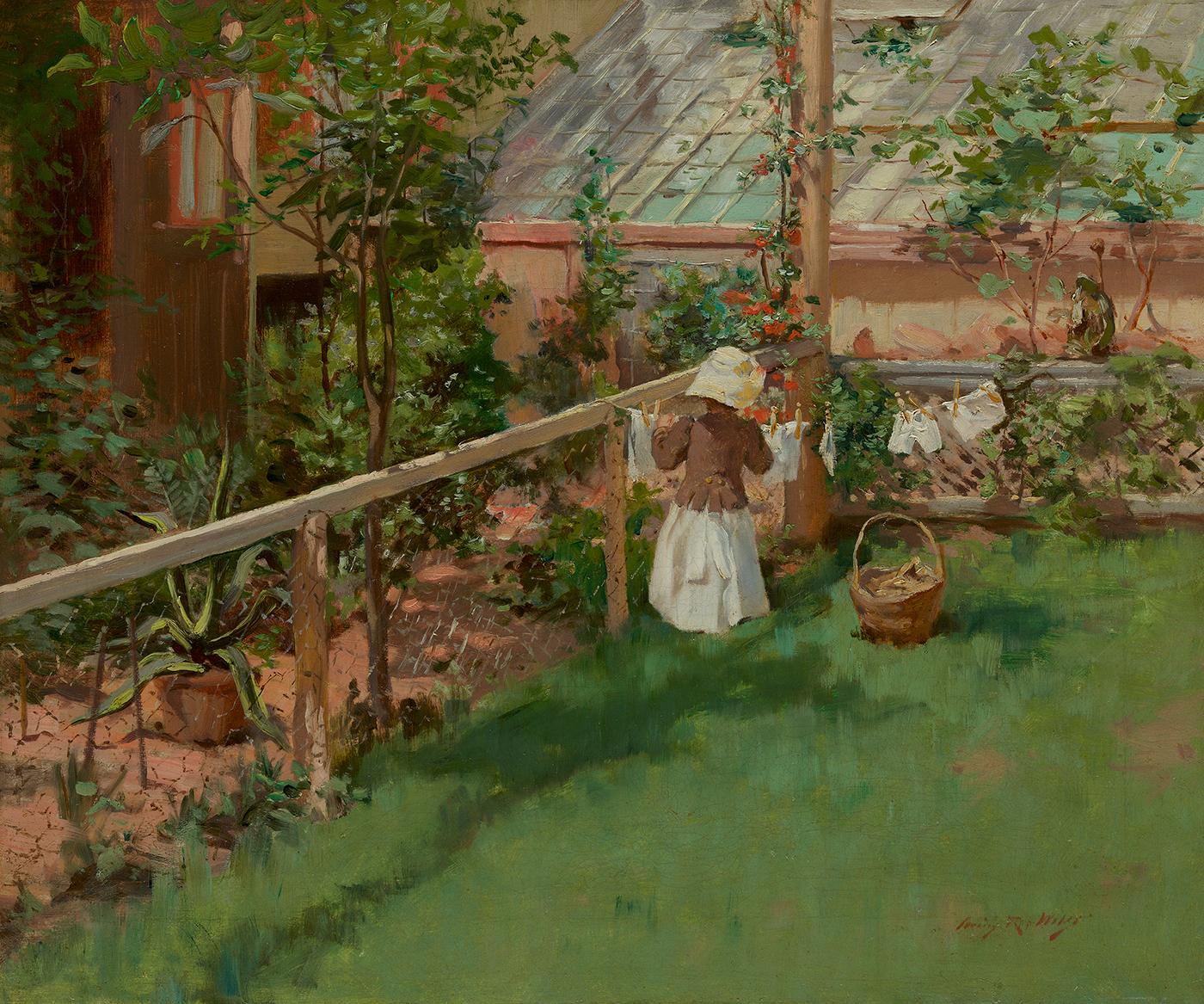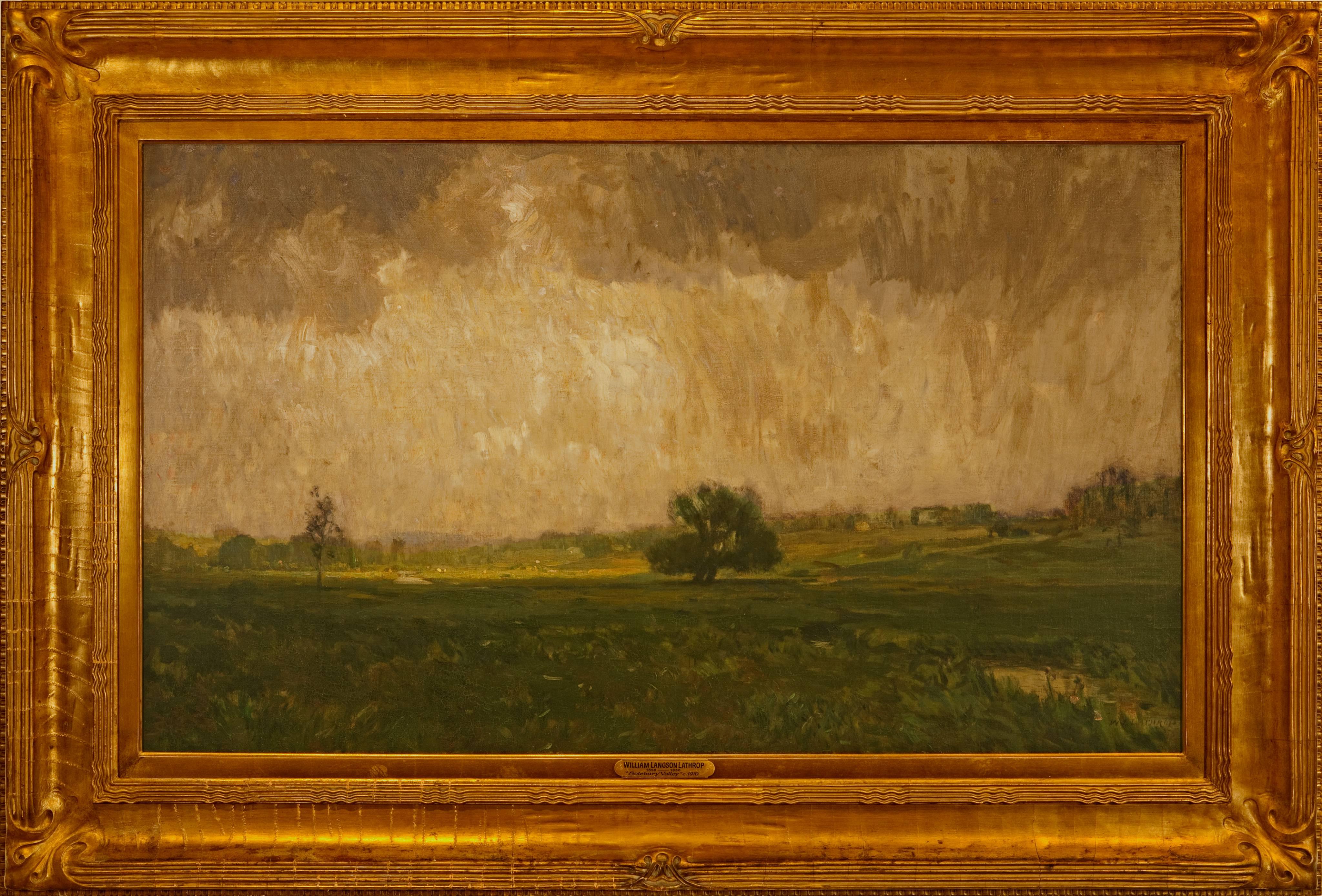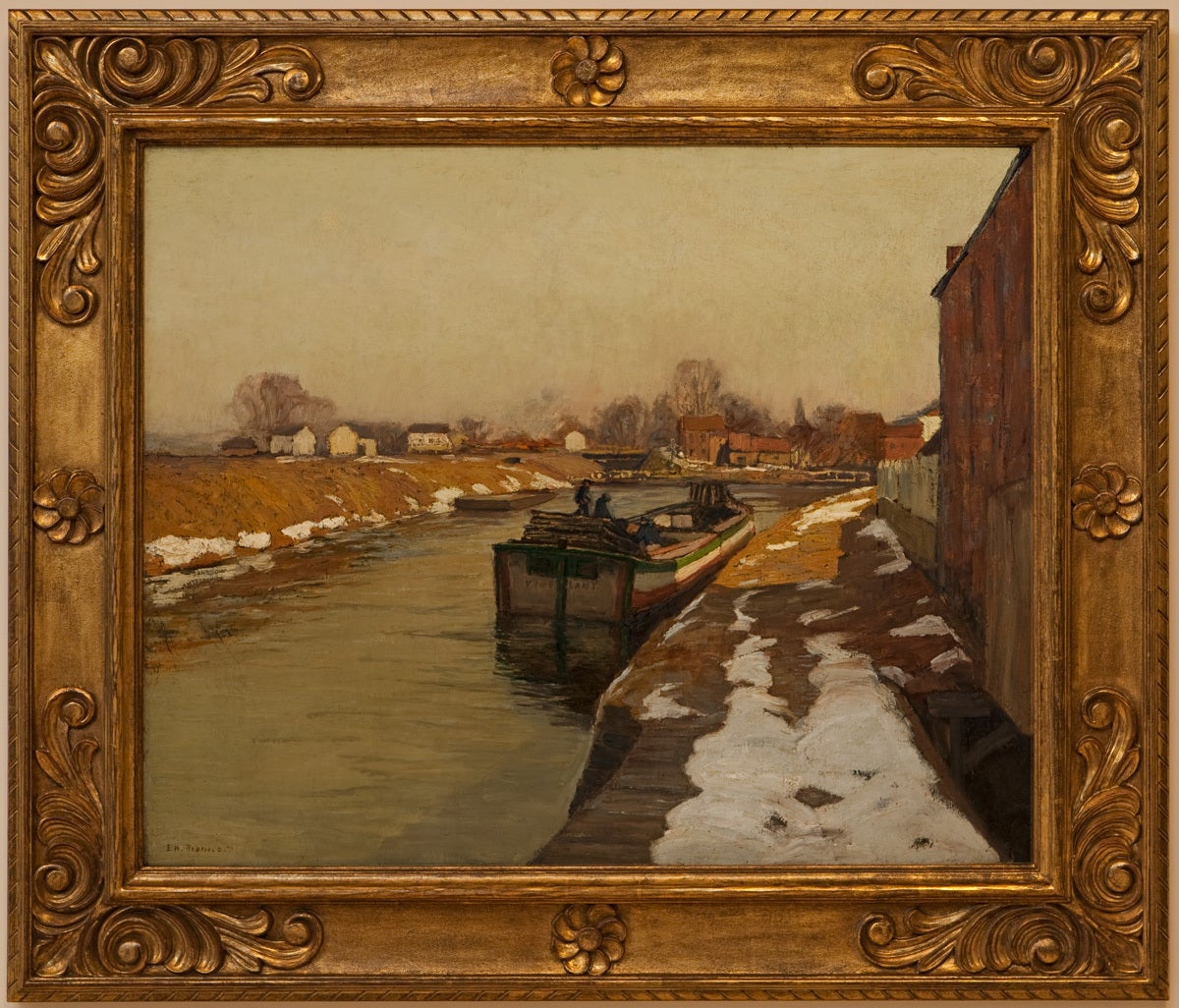Items Similar to 'Summer Days', Idyllic American Landscape, Children, Arts & Crafts Architecture
Want more images or videos?
Request additional images or videos from the seller
1 of 13
American School (20th century)'Summer Days', Idyllic American Landscape, Children, Arts & Crafts ArchitectureCirca 1920
Circa 1920
About the Item
A substantial, early twentieth-century oil showing two children, wearing period summer dress and posed beside a well, with a view beyond across lush green lawns towards a substantial Arts and Crafts style house with a stand of trees in the distance; an elegant and well-composed American School landscape suffused with the warmth and light of a summer's afternoon. Unsigned and painted circa 1910.
- Creator:American School (20th century)
- Creation Year:Circa 1920
- Dimensions:Height: 28 in (71.12 cm)Width: 22 in (55.88 cm)Depth: 0.75 in (1.91 cm)
- Medium:
- Movement & Style:
- Period:
- Condition:canvas strip-lined and mounted on new stretcher, minor restoration, minor losses; unframed. shows well.
- Gallery Location:Santa Cruz, CA
- Reference Number:1stDibs: LU3448465282
About the Seller
5.0
Platinum Seller
These expertly vetted sellers are 1stDibs' most experienced sellers and are rated highest by our customers.
Established in 1982
1stDibs seller since 2013
629 sales on 1stDibs
Typical response time: <1 hour
- ShippingRetrieving quote...Ships From: Santa Cruz, CA
- Return PolicyA return for this item may be initiated within 3 days of delivery.
More From This SellerView All
- 'River Landscape', American Impressionist, Carmel Art Association, Plein AirBy Mae Hill GilbertLocated in Santa Cruz, CAImpressionist-style California landscape with eucalyptus trees growing beside a river and a view beyond towards distant hills. Signed lower left "M. Gilbert" (American, 1867-1945) for Mae Hill Gilbert and painted circa 1940. Born in Illinois, Mae Gilbert was living in Monterey by the 1930s and exhibiting at the Carmel Art Association. Her son, Arthur Hill...Category
1940s American Impressionist Landscape Paintings
MaterialsFoam Board, Oil, Canvas
- 'New England Coast', Paris, New York, Royal Academy of Art, London, BenezitBy Hugo Melville FisherLocated in Santa Cruz, CASigned lower right, "H. Melville Fisher" for Hugo Melville Fisher (American, 1878-1946) and painted circa 1925. Inscribed on stretcher, verso, 'New England Rocky Seashore'. A substantial, Impressionist seascape by this Paris-trained and well-listed, American Modernist. Born in Brooklyn, Hugo Melville Fisher first studied with his father, the landscape painter Hugo Anton Fisher...Category
1920s American Impressionist Landscape Paintings
MaterialsCanvas, Oil
- 'Caulking the Seams', American Impressionist School Oil, Sailing Boat, SchoonerLocated in Santa Cruz, CAAn early twentieth-century, American School oil showing a view of a sailor caulking the seams of a substantial wooden sailing ship with a view beyond towards red-tiled houses beneath...Category
1920s American Impressionist Landscape Paintings
MaterialsOil, Canvas
- 'Montana Hills', Academy of Arts, Berlin, National Academy of DesignBy Carl RungiusLocated in Santa Cruz, CASigned lower right, 'C. Rungius' for Carl Rungius (German-American, 1869-1959) and titled, verso, 'Montana Landscape VIII'. Displayed in an ebony pa...Category
1920s American Impressionist Landscape Paintings
MaterialsCanvas, Oil, Board
- 'Point Lobos, China Cove', Carmel, California Impressionist Oil, MontereyLocated in Santa Cruz, CASigned lower left, 'Edward Glafke' (American, 1925-1997); additionally signed, verso, titled, 'Point Lobos, China Cove', and dated 1993. Edward Glafke w...Category
1990s American Impressionist Landscape Paintings
MaterialsCanvas, Oil
- 'Big Surf, Point Lobos' California Impressionism, Carmel Art Association, TaosBy Edward Norton WardLocated in Santa Cruz, CASigned lower right, 'Edward Norton Ward' (American, born 1928) and painted circa 1960; additionally signed, verso, and titled 'Heavy Seas, Pt. Lobos'. A substantial evening seascape showing dramatic breakers rolling in towards the the rocky coast near Point Lobos, California. This plein-air Impressionist painter first attended the University of California in Los Angeles and subsequently studied with Joshua Meador. Over the course of a long career, he has exhibited widely and with success and has been the recipient of numerous medals, prizes and juried awards. Edward Norton Ward was a charter member of the Society of American Impressionists; he is also a member of the California Art Club and has served as president of the Carmel Art...Category
1960s American Impressionist Landscape Paintings
MaterialsCanvas, Oil
You May Also Like
- At the ClotheslineBy Irving Ramsey WilesLocated in New York, NYSigned lower right: Irving R. WilesCategory
Late 19th Century American Impressionist Landscape Paintings
MaterialsCanvas, Oil
- "Alley Fiends"By John R. GrabachLocated in Lambertville, NJJim’s of Lambertville is proud to offer this artwork by: John R. Grabach (1886 - 1981) John Grabach was a highly regarded New Jersey artist, teacher, and author of the classic text...Category
1930s American Impressionist Landscape Paintings
MaterialsCanvas, Oil
- "Forest Strongholds"By John F. CarlsonLocated in Lambertville, NJSigned lower right. Complemented by a hand carved and gilt frame. Exhibited at the National Academy of Design, 1928Category
20th Century American Impressionist Landscape Paintings
MaterialsCanvas, Oil
- "Solebury Valley"By William Langson LathropLocated in Lambertville, NJSigned lower right. Complemented by a period frame. William L. Lathrop (1859-1938) Deemed “Father of the New Hope Art Colony”, William Langson Lathrop was born in Warren, Illinois. He was largely self-taught, having only studied briefly with William Merritt Chase in 1887, at the Art Students League. Lathrop first moved east in the early 1880s, and took a job at the Photoengraving Company in New York City. While there, he befriended a fellow employee, Henry B. Snell. The two men became lifelong friends and ultimately, both would be considered central figures among the New Hope Art Colony. Lathrop's early years as an artist were ones of continuing struggle. His efforts to break through in the New York art scene seemed futile, so he scraped enough money together to travel to Europe with Henry Snell in1888. There he met and married an English girl, Annie Burt. Upon returning to New York, he tried his hand at etching, making tools from old saw blades...Category
1910s American Impressionist Landscape Paintings
MaterialsCanvas, Oil
- Winter MoonlightBy George William SotterLocated in Lambertville, NJsigned lower rightCategory
1910s American Impressionist Landscape Paintings
MaterialsCanvas, Oil
- "The Canal"By Edward Willis RedfieldLocated in Lambertville, NJJim’s of Lambertville is proud to offer this artwork. Signed lower left. Complemented by a hand carved and gilt frame. Illustrated in "Edward Redfield: Just Values and Fine Seeing" by Constance Kimmerle and the Pennsylvania Academy of the Fine Arts's Exhibition of Paintings by Edward Redfield (April 17 to May 16, 1909) brochure Edward Willis Redfield (1869 - 1965) Edward W. Redfield was born in Bridgeville, Delaware, moving to Philadelphia as a young child. Determined to be an artist from an early age, he studied at the Spring Garden Institute and the Franklin Institute before entering the Pennsylvania Academy from 1887 to 1889, where he studied under Thomas Anshutz, James Kelly, and Thomas Hovenden. Along with his friend and fellow artist, Robert Henri, he traveled abroad in 1889 and studied at the Academie Julian in Paris under William Bouguereau and Tony Robert-Fleury. While in France, Redfield met Elise Deligant, the daughter of an innkeeper, and married in London in 1893. Upon his return to the United States, Redfield and his wife settled in Glenside, Pennsylvania. He remained there until 1898, at which time he moved his family to Center Bridge, a town several miles north of New Hope along the Delaware River. Redfield painted prolifically in the 1890s but it was not until the beginning of the twentieth century that he would develop the bold impressionist style that defined his career. As Redfield’s international reputation spread, many young artists gravitated to New Hope as he was a great inspiration and an iconic role model. Edward Redfield remained in Center Bridge throughout his long life, fathering his six children there. Around 1905 and 1906, Redfield’s style was coming into its own, employing thick vigorous brush strokes tightly woven and layered with a multitude of colors. These large plein-air canvases define the essence of Pennsylvania Impressionism. By 1907, Redfield had perfected his craft and, from this point forward, was creating some of his finest work. Redfield would once again return to France where he painted a small but important body of work between 1907 and 1908. While there, he received an Honorable Mention from the Paris Salon for one of these canvases. In 1910 he was awarded a Gold Medal at the prestigious Buenos Aires Exposition and at the Panama-Pacific Exposition of 1915 in San Francisco, an entire gallery was dedicated for twenty-one of his paintings. Since Redfield painted for Exhibition with the intent to win medals, his best effort often went into his larger paintings. Although he also painted many fine smaller pictures, virtually all of his works were of major award-winning canvas sizes of 38x50 or 50x56 inches. If one were to assign a period of Redfield’s work that was representative of his “best period”, it would have to be from 1907 to 1925. Although he was capable of creating masterpieces though the late 1940s, his style fully matured by 1907 and most work from then through the early twenties was of consistently high quality. In the later 1920s and through the 1930s and 1940s, he was like most other great artists, creating some paintings that were superb examples and others that were of more ordinary quality. Redfield earned an international reputation at a young age, known for accurately recording nature with his canvases and painting virtually all of his work outdoors; Redfield was one of a rare breed. He was regarded as the pioneer of impressionist winter landscape painting in America, having few if any equals. Redfield spent summers in Maine, first at Boothbay Harbor and beginning in the 1920s, on Monhegan Island. There he painted colorful marine and coastal scenes as well as the island’s landscape and fishing shacks. He remained active painting and making Windsor style furniture...Category
Early 1900s American Impressionist Landscape Paintings
MaterialsCanvas, Oil
Recently Viewed
View AllMore Ways To Browse
Antique Style Houses
Arts And Crafts Style Art
Early Twentieth Century
Dress Days
Arts And Crafts Style Light
Arts Crafts Trees
Architectural Dress
Afternoon Dress
Antique Childrens Dresses
Antique School House Light
Antique Lawn
Green Lawn
Antique Lawn Dress
Scottish Loch
French Battle Scene
Antique Oil Seascape
Le Cloud
Sky Map





